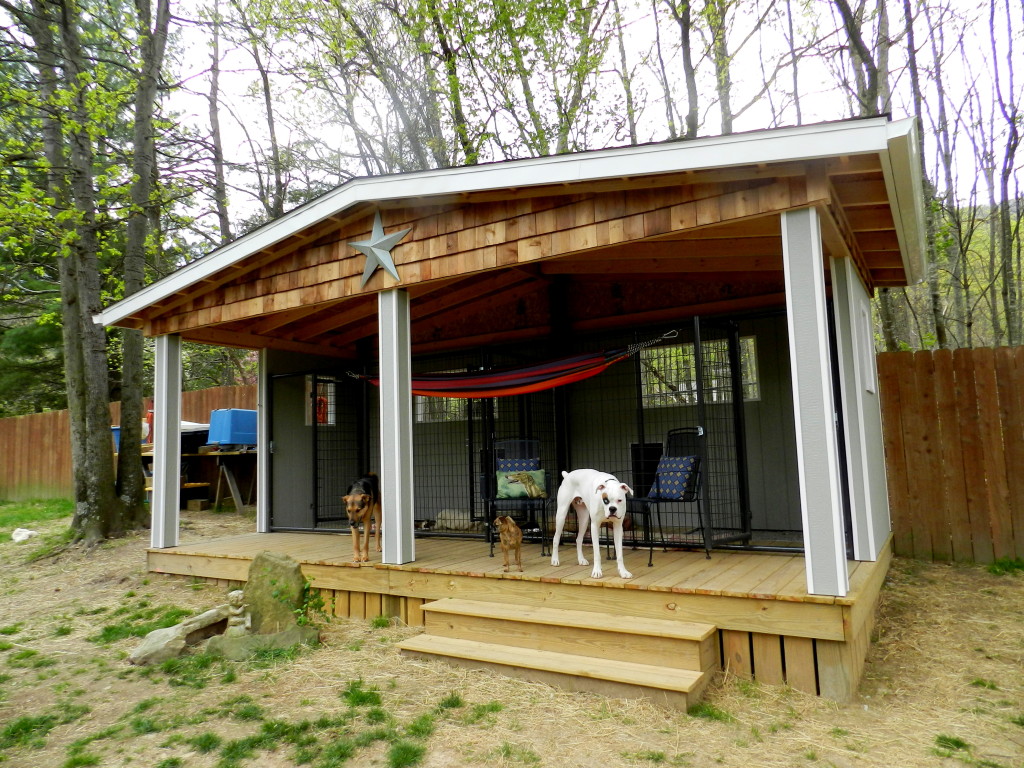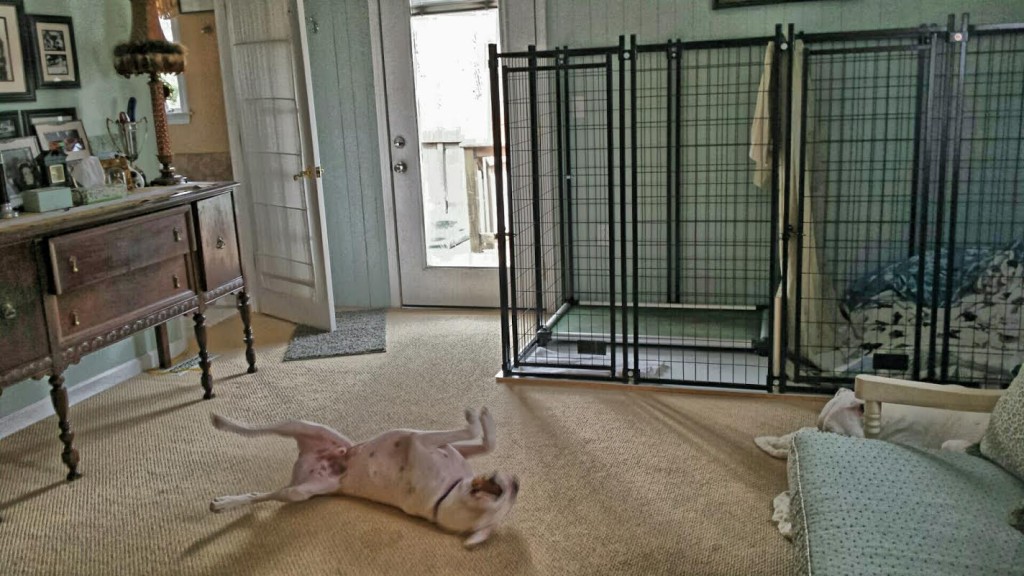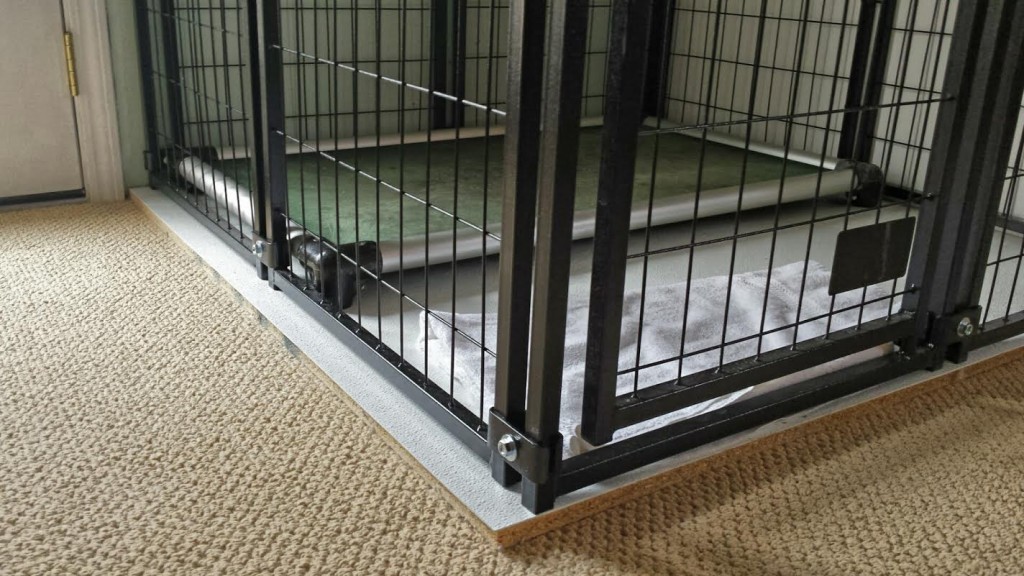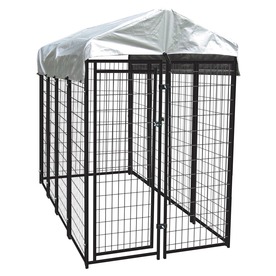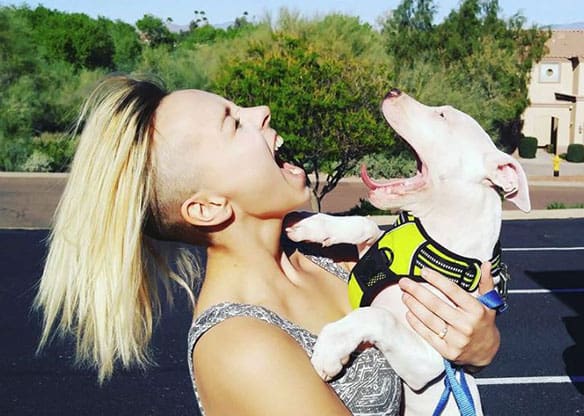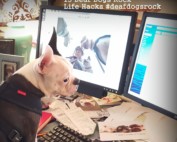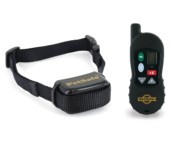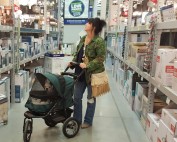Separation Anxiety is when deaf dogs are left alone unattended and they become destructive. If you leave your deaf dog alone and your deaf dog proceeds to urinate, defecate, barks non-stop, digs up floors and rugs, chews up furniture, or tries to escape his crate, then there is a strong possibility your dog has SA. When you leave your dog all alone and then you see symptoms of distress then most likely you will have to come up with solutions on how you can successfully overcome Separation Anxiety or SA.
Lately I have been getting more and more questions about separation anxiety (SA) then any other questions about deaf dogs. First let me start by saying NEVER EVER let your new deaf puppy sleep in bed with you. I would say more than half of the emails I get are from people who let their new deaf puppy sleep with them (instead of properly crate training the puppy) and now many months later the deaf dog has separation anxiety.
Many of the deaf dogs who end up in shelters around the country are there simply because of separation anxiety which could have been avoided. When we fostered and then adopted our deaf dog Bud at 11 months old he had mild separation anxiety as well as Obsessive Compulsive Disorder. My husband Chris and I had to carefully figure out how we were going to go into town, run errands, go to appointments or just get the simplest of tasks completed without Bud hurting himself or destroying the house!
Usually Chris and I will go into town to run errands at different times so someone will always be home with Bud. Being the amazing carpenter that he is, Chris built a beautiful dog house with strong steel kennels inside so when the weather is warm, Bud and Nitro can go into the kennel with their peanut butter stuffed Kongs and enjoy them for a few hours (see the kennels below for a low cost alternative to building a big dog house). This worked for Bud because his SA was mild. If you have a dog with severe SA the stuffed Kong will not work so it is vital you work with a professional trainer to come up with a plan or to do some serious research on the subject so you can come up with a successful plan on your own.
By taking the initiative of setting up a nice strong kennel and dog house, Chris and I finally have a chance at doing things together once in a while. We also installed a ceiling fan right above the kennels to keep both Nitro and Bud cool. Bud no longer shows signs of SA but it took many short sessions of leaving him alone. We started off with just 5 minutes at first or when we were working out in the yard and increased time as he felt more comfortable in his new kennel.
I want to share a couple of really good sources and links to help you with your deaf dog’s (or hearing dog’s) separation anxiety. This way so you can do your own research on how you can deal with your deaf dog’s separation anxiety. If you get a chance I also recommend ordering the book by trainer Patricia McConnell called “I’ll Be Home Soon” which also deals with K9 separation anxiety. I hope these resources help you help your deaf dog get over or at the very least be able to live with SA.
With crates being as expensive as they are (for Large or XL crates), we decided to add some kennels inside here at the Deaf Dogs Rock headquarters to house some of the foster puppies we take in temporarily. Sometimes we do get in Deaf dogs/puppies who have developed different levels of separation anxiety. Since dogs with SA tend to shred everything in their kennels we ordered and installed a Kuranda aluminum dog bed that can not be shredded (see left kennel below).
The deaf dogs and puppies who visit us here at DDR don’t seem to mind the kennels because they are larger and more open then a regular dog crate. These kennels run between $239.00 – $250 (for a 4ft x 4ft).They come with a cover if you want to install a kennel outside so the dog will have shade and be protected from the weather. For the money these kennels are a great alternative to a crate. With my big outside kennels, I do worry about snakes and bees so this kennel used indoors is a perfect solution to have our foster puppies inside the house and out of extreme weather.
I have noticed it helps with the pup’s separation anxiety if the puppy can see another dog right next to them (if they are dog friendly). When we feed the dog’s in their kennels we do put up a sheet in the middle divider so they can’t see each other when they are eating (this is more relaxing for them to take their time and eat their meals and not feel rushed) but remember to remove the sheet after they eat or the dog with SA will shred it!
The two kennels in the photo below are 4 x 4 but they also have an 8ft x 4ft x 6ft kennel for around $450.
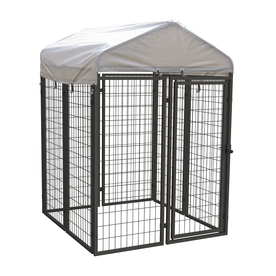 [easyazon_link identifier=”B000OA7UR2″ locale=”US” tag=”deafdogsrock-20″]Click here for a link to the kennel above (4ft x 4ft with a cover).[/easyazon_link]
[easyazon_link identifier=”B000OA7UR2″ locale=”US” tag=”deafdogsrock-20″]Click here for a link to the kennel above (4ft x 4ft with a cover).[/easyazon_link]
Photo above. A piece of coated plywood runs about $30

[easyazon_infoblock align=”none” identifier=”B004E2JWNG” locale=”US” tag=”deafdogsrock-20″]
Kennel shown above is a 8ft x 4ft x 6 ft with a cover. [easyazon_link identifier=”B000OA7UR2″ locale=”US” tag=”deafdogsrock-20″]Click here for pricing and info.[/easyazon_link]
Happy training! ~ Christina Lee – Deaf Dogs Rock
Photo above: Bud with my husband Chris. He hates to be alone and he will destroy the house if given the chance.
The first is from the ASPCA.org/Top Tips for Overcoming Separation Anxiety.
For many dogs, even the slightest change in daily routines can be upsetting. In response, poor Fido may start acting disruptive or destructive, especially when left home alone. He may resort to urinating and defecating indoors, howling, chewing, pacing or trying to escape from the house or yard. When these issues are accompanied by signs of panic, distress or depression, they may indicate your pooch suffers from separation anxiety.
But don’t fear—we’re here to help! When treating a dog with separation anxiety, the goal is to resolve the underlying issue by teaching him to enjoy—or at least tolerate—being left alone. Our experts have put together a list of top tips for helping your pooch overcome separation anxiety.
Doctor Knows Best: The first step in tackling behavior issues is to rule out any underlying medical problems that might be causing your pet’s behavior. For example, if your pet is urinating in the house, he might be suffering from a urinary tract infection, bladder stones, diabetes or kidney disease—all of which can cause urinary incontinence in dogs.
Conquer Fear: If your pooch suffers mild separation anxiety, counter conditioning—or helping your dog associate being alone with something good, like a tasty treat—might reduce or resolve the problem. To develop this kind of association, offer your dog a food-dispensing toy every time you leave the house.
Dogs Need Jobs: Providing lots of physical and mental stimulation is a vital part of treating many behavior problems, especially those involving anxiety. Exercise can enrich your dog’s life, decrease stress and provide appropriate outlets for normal behavior. Plus, a tired dog doesn’t have much excess energy to burn when he’s left alone!
Prepare for Departure: Many dogs know when you’re about to leave the house and will get anxious or prevent your departure altogether. One way to tackle “predeparture anxiety” is to teach your dog that when you pick up your keys or put on your coat, it doesn’t always mean you’re leaving. For example, put on your boots and coat, and then just sit down and watch TV instead of leaving.
Take Baby Steps: If your dog’s anxiety falls more on the severe side of things, try getting your pooch used to being alone by starting small or “desensitizing” him to the cause of his fear. Begin by introducing several short periods of separation that don’t produce anxiety, and then gradually increase time spent apart over the course of a few weeks.
To read the full article from the ASPCA.org, please click here.
Center For Shelter Dogs – Separation Anxiety
Dogs with separation anxiety may bark/howl, be destructive and urinate and/or
defecate in the house when left alone. The behaviors hardly ever occur when an owner is
with a dog. All of the behaviors occur soon after the dog is left alone and may (barking)
go on for hours. The destructive behavior tends to be centered around doors and
windows. Dogs often chew doorways and windowsills or pull up carpeting by the front
door.
Many dogs display signs of separation anxiety shortly after arriving in their new
homes. Most get over it. Here are some things you can do to help your dog adjust
sooner.
PRACTICE SHORT DEPARTURES On our dog’s first day in your
home start to leave the house for very short times. It’s very important
to pay no attention to your dog when you do the departures. First just
go in and out the door. If your dog doesn’t panic, take the trash
outside or pick up your mail. Then, leave the house for 5-minute
intervals. Then try 10 minutes. If you take your car to work, make
sure you drive your car away. Over the first two days, try to progress
up to 30 minutes. Make sure you allow your dog to relax between
departures. If your dog panics SLOW DOWN! Wait a couple of
hours before doing another departure and make it short. The goal is to
have your dog relax when left alone. If you are patient and don’t go
faster than your dog can tolerate both of you will be happier.
IGNORE YOUR DOG WHEN YOU COME AND GO Making too
big a deal of your departures will teach your dog to make a big deal of
departures. Ignore your dog when leaving and don’t have a party
when you come back.
DON’T LET YOUR DOG BE A VELCRO DOG Discourage
allowing your dog to follow you everywhere. Staying in another room
will help your dog learn that being alone is not dangerous. Don’t
allow your dog to sit next to you all the time. Resting and sleeping
while not touching you will help your dog feel more confident when
alone.
GIVE YOUR DOG A DELICIOUS AND LONG-LASTING CHEW
BEFORE YOU LEAVE Although many anxious dogs won’t eat when
left alone, some will and when they do, their anxiety is reduced.
Leaving a very delicious chew may be something a dog just can’t
To read the full article on Center for Shelter Dogs – Separation Anxiety, please click here.
Separation Anxiety from the Humane Society.
What causes separation anxiety
It’s not fully understood why some dogs suffer from separation anxiety and others don’t. But it’s important to realize that the destruction and house soiling that often occur with separation anxiety are part of a panic response. Your dog isn’t trying to punish you for leaving her alone.
These are some of the scenarios that can trigger separation anxiety:
- A dog accustomed to constant human companionship is left alone for the first time.
- A dog suffers a traumatic event (from her viewpoint), such as time at a shelter or boarding kennel.
- There’s a change in the family’s routine or structure or the loss of a family member or other pet.
How to treat minor separation anxiety
- Don’t make a big deal out of arrivals and departures. For example, when you arrive home, ignore your dog for the first few minutes then calmly pet him.
Leave your dog with an article of clothing that smells like you, such as an old T-shirt that you’ve slept in recently. - Establish a safety cue—a word or action that you use every time you leave that tells your dog you’ll be back.
- Consider using an over-the-counter calming product that may reduce fearfulness in dogs.
How to handle a more severe problem
Use the techniques outlined above along with desensitization training. Teach your dog the sit-stay and down-stay commands using positive reinforcement. This training will help her learn that she can remain calmly and happily in one place while you go to another room.
Create a “safe place” to limit your dog’s ability to be destructive. A safe place should:
- Confine loosely rather than strictly (a room with a window and distractions rather than total isolation)
- Contain busy toys for distraction
- Have dirty laundry to lend a calming olfactory cue or other safety cues.
How to cope while your dog learns to be calm
It can take time for your dog to unlearn his panic response to your departures. To help you and your dog cope in the short term, consider the following interim solutions:
- Ask your veterinarian about drug therapy. A good anti-anxiety drug shouldn’t sedate your dog but simply reduce his overall anxiety.
- Take your dog to a doggie day care facility or kennel when you have to be away.
- Leave your dog with a friend, family member, or neighbor when you’re away.
- Take your dog to work with you, if possible.
To read the full article on www.humanesociety.org please click here.

